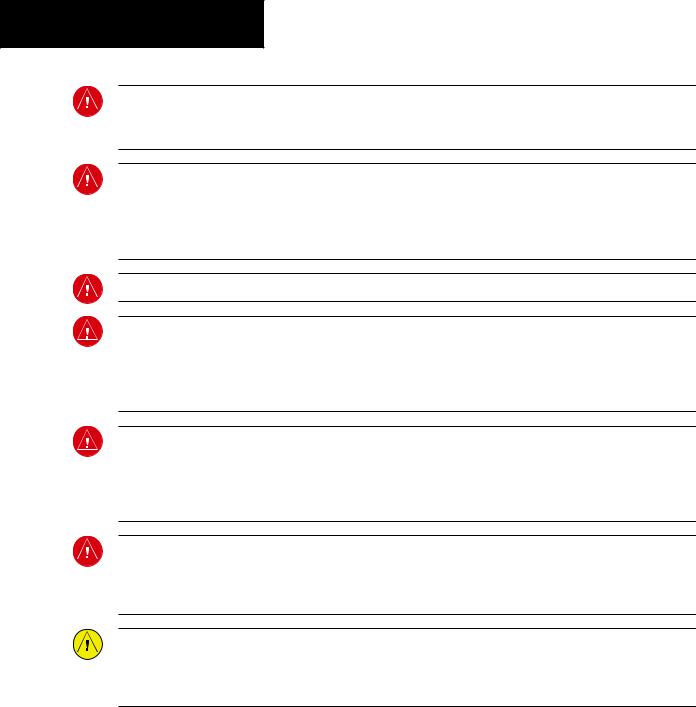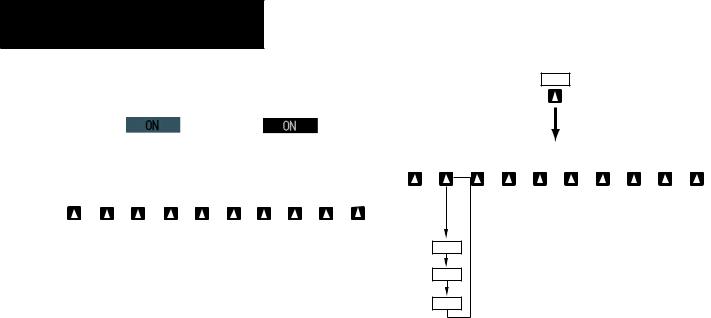
- •SECTION 1: System Overview
- •1.1 PFD/MFD Controls
- •1.2 PFD Softkeys
- •1.3 MFD Softkeys
- •1.4 MFD Page Groups
- •1.5 Backlighting
- •1.6 XM Radio - Automatic Muting
- •Section 2: FLIGHT INSTRUMENTS
- •2.1 Airspeed Indicator
- •Speed Indication
- •Speed Ranges
- •Airspeed Trend Vector
- •Vspeed References
- •2.2 Attitude Indicator
- •2.3 Altimeter
- •Altitude Reference Bug
- •Altitude Trend Vector
- •Barometric Setting Box
- •2.4 Vertical Deviation/Glideslope Indicator
- •2.5 Marker Beacon Annunciations
- •2.6 Vertical Speed Indicator
- •2.7 Horizontal Situation Indicator (HSI)
- •Course Pointer
- •Course Deviation Indicator (CDI)
- •Bearing Pointers and Information Windows
- •DME Radio (optional)
- •Navigation Source
- •3.1 Engine Display
- •3.2 Lean Engine Display
- •3.3 Engine System Display
- •4.1 Radio Status Indications
- •4.2 Volume
- •4.3 Automatic Squelch
- •4.4 Quickly Activating 121.500 MHz
- •4.5 Optional NAV Radios
- •DME Radio (optional)
- •ADF Radio (optional)
- •Auto-tuning on the PFD
- •Auto-tuning on the MFD
- •4.7 Transponder
- •Mode Selection
- •Ground Mode (Automatic)
- •Reply Status
- •Code Selection
- •Flight ID Reporting
- •5.1 COM Radio Selection
- •5.2 Marker Beacon Receiver
- •Marker Beacon Signal Sensitivity
- •5.3 Nav Radio Audio Selection
- •5.4 Intercom System (ICS) Isolation
- •5.5 Intercom Squelch Control
- •5.6 Digital Clearance Recorder with Playback Capability
- •Section 7: Navigation
- •7.1 Navigation Map Page
- •Select the MAP Page Group
- •Direct-to Navigation from the MFD
- •Direct-to Navigation from the PFD
- •7.3 Airport Information
- •Select the Airport Information Page
- •Enter a Waypoint Facility Name or City Location:
- •Access Runway Information
- •Access Frequency Information
- •7.4 Intersection Information
- •Select the Intersection Information Page
- •Access Information on an Intersection
- •7.5 NDB Information
- •Select the NDB Information Page
- •7.6 VOR Information
- •Select the VOR Information Page
- •Access Information on a VOR:
- •7.7 User Waypoint Information Page
- •7.8 Nearest Airports
- •Nearest Airport Information on the MFD
- •Nearest Airports Information on the PFD
- •7.9 Nearest Intersections
- •Select the Nearest Intersections Page
- •View Information on the Nearest Intersection
- •7.10 Nearest NDB
- •Select the Nearest NDB Page
- •7.11 Nearest VOR
- •Select the Nearest VOR Page
- •View Information on the Nearest VOR:
- •Select and Load a VOR Frequency
- •7.12 Nearest User Waypoint
- •Select the Nearest User Waypoint Page
- •Select a Nearest User Waypoint
- •7.13 Nearest Frequencies
- •Select the Nearest Frequencies Page
- •7.14 Nearest Airspaces
- •Select the Nearest Airspaces Page
- •Airspace Alerts Box
- •View Additional Details for a Listed Airspace
- •View and Quickly Load the Frequency for a Controlling Agency
- •sECTION 8: fLIGHT PLANNING
- •8.1 User Defined Waypoints
- •Select the User WPT Information Page
- •Create a New User Waypoint
- •Create User Waypoints from the Navigation Map Page
- •Modify a User Waypoint
- •Delete a User Waypoint
- •8.2 Viewing the Active Flight Plan
- •8.3 Activate a Stored Flight Plan
- •8.4 Activate a Flight Plan Leg
- •8.5 Stop Navigating a Flight Plan
- •8.6 Invert Active Flight Plan
- •8.7 Create a New Flight Plan
- •8.8 Load a Departure
- •8.9 Load an Arrival
- •8.10 Load an Approach
- •8.12 Store A Flight Plan
- •8.13 Edit a Stored Flight Plan
- •8.14 Delete a Waypoint from the Flight Plan
- •8.15 Invert and activate a Stored Flight Plan
- •8.16 Copy a Flight Plan
- •8.17 Delete a Flight Plan
- •8.18 Graphical Flight Plan Creation
- •8.19 Trip Planning
- •Section 9: Procedures
- •9.1 Arrivals and Departures
- •Load and Activate a Departure Procedure
- •Load and Activate An Arrival Procedure
- •9.2 Approaches
- •Load and/or Activate an Approach Procedure
- •Activate An Approach in the Active Flight Plan
- •Section 10: Hazard Avoidance
- •10.1 Customizing the Hazard Displays on the Navigation Map
- •10.2 STORMSCOPE® (Optional)
- •Displaying Stormscope Lightning Data on the Navigation Map Page
- •Stormscope Page
- •10.3 XM Weather (Service Optional)
- •Displaying Weather on the Weather Data Link Page
- •NEXRAD Limitations
- •Weather Product Age
- •10.4 Traffic Information Service (TIS)
- •TIS Audio Alert
- •10.5 Traffic Advisory System (TAS) (Optional)
- •System Self Test
- •10.6 Terrain And Obstacle Proximity
- •Displaying Terrain and Obstacles on the Terrain Proximity Page
- •11.1 Reversionary Mode
- •11.2 Abnormal COM Operation
- •11.3 Unusual Attitudes
- •12.1 Alert Level Definitions
- •12.2 NAV III Aircraft Alerts
- •Voice Alerts
- •WARNING Alerts
- •CAUTION Alerts
- •12.3 G1000 System Annunciations
- •MFD & PFD Message Advisories
- •Database Message Advisories
- •GMA 1347 Message Advisories
- •GIA 63 Message Advisories
- •GIA 63 Message Advisories (Cont.)
- •GEA 71 Message Advisories
- •GTX 33 Message Advisories
- •GRS 77 Message Advisories
- •GMU 44 Message Advisories
- •GDL 69 Message Advisories
- •GDC 74A Message Advisories
- •Miscellaneous Message Advisories
- •Index

G1000TM
cockpit reference guide for the Cessna Nav III

Copyright © 2004, 2005 Garmin Ltd. or its subsidiaries. All rights reserved.
This manual reflects the operation of System Software versions 0394.03 or later for Cessna 172R aircraft,0395.04 or later for Cessna 172S aircraft, 0371.08 or later for normally aspirated Cessna 182 aircraft, 0372.07 or later for turbocharged Cessna 182 aircraft, 0373.04 or later for normally aspirated Cessna 206 aircraft, and 0374.04 or later for turbocharged Cessna 206 aircraft. Some differences in operation may be observed when comparing the information in this manual to earlier or later software versions.
NOTE: Cessna Nav III aircraft include the Cessna 172R, the Cessna 172S, the normally aspirated Cessna 182 (182), the turbocharged Cessna 182 (T182), the normally aspirated Cessna 206 (206), and the turbocharged Cessna 206 (T206). Unless otherwise indicated, information in the G1000 Cockpit Reference Guide pertains to all Cessna Nav III aircraft.
Garmin International, Inc., 1200 East 151st Street, Olathe, Kansas 66062, U.S.A.
Tel: 913/397.8200 |
Fax: 913/397.8282 |
GarminAT, Inc., 2345Turner Road SE, Salem, OR 97302, U.S.A. |
|
Tel: 503/391.3411 |
Fax 503/364.2138 |
Garmin (Europe) Ltd., Unit 5,The Quadrangle,Abbey Park Industrial Estate, Romsey, Hampshire S051 9DL, U.K. |
|
Tel: 44/0870.8501241 |
Fax: 44/0870.8501251 |
Garmin Corporation, No. 68, Jangshu 2nd Road, Shijr,Taipei County,Taiwan |
|
Tel: 886/02.2642.9199 |
Fax: 886/02.2642.9099 |
Web SiteAddress: www.garmin.com
Except as expressly provided herein, no part of this manual may be reproduced, copied, transmitted, disseminated, downloaded or stored in any storage medium, for any purpose without the express written permission of Garmin. Garmin hereby grants permission to download a single copy of this manual and of any revision to this manual onto a hard drive or other electronic storage medium to be viewed for personal use, provided that such electronic or printed copy of this manual or revision must contain the complete text of this copyright notice and provided further that any unauthorized commercial distribution of this manual or any revision hereto is strictly prohibited.
Garmin® is a registered trademark of Garmin Ltd. or its subsidiaries, and G1000™ is a trademark of Garmin Ltd. or its subsidiaries. These trademarks may not be used without the express permission of Garmin.
NavData® is a registered trademark of Jeppesen, Inc.; Stormscope® is a registered trademark of L-3 Communications; and XM® is a registered trademark of XM Satellite Radio, Inc., Honeywell® and Bendix/King® are registered trademarks of Honeywell International, Inc.
July 2005 |
190-00384-04 Rev. B |
Printed in the U.S.A. |
Garmin G1000 Cockpit Reference Guide for the Cessna Nav III

WARNINGS,
CAUTIONS, & NOTES
WARNING: Navigation and terrain separation must NOT be predicated upon the use of the terrain function. The G1000 Terrain Proximity feature is NOT intended to be used as a primary reference for terrain avoidance and does not relieve the pilot from the responsibility of being aware of surroundings during flight. The Terrain Proximity feature is only to be used as an aid for terrain avoidance and is not certified for use in applications requiring a certified terrain awareness system. Terrain data is obtained from third party sources. Garmin is not able to independently verify the accuracy of the terrain data.
WARNING: The displayed minimum safe altitudes (MSAs) are only advisory in nature and should not be relied upon as the sole source of obstacle and terrain avoidance information. Always refer to current aeronautical charts for appropriate minimum clearance altitudes.
WARNING:The altitude calculated by G1000 GPS receivers is geometric height above Mean Sea Level and could vary significantly from the altitude displayed by pressure altimeters, such as the GDC 74A Air Data Computer, or other altimeters in aircraft. GPS altitude should never be used for vertical navigation. Always use pressure altitude displayed by the G1000 PFD or other pressure altimeters in aircraft.
WARNING: The Jeppesen database used in the G1000 system must be updated regularly in order to ensure that its information remains current. Updates are released every 28 days. A database information packet is included in the G1000 package. Pilots using an outdated database do so entirely at their own risk.
WARNING: The basemap (land and water data) must not be used for navigation, but rather only for non-navi- gational situational awareness. Any basemap indication should be compared with other navigation sources.
WARNING: Traffic information shown on the G1000 Multi Function Display is provided as an aid in visually acquiring traffic. Pilots must maneuver the aircraft based only uponATC guidance or positive visual acquisition of conflicting traffic.
WARNING: Use of the Stormscope interface for hazardous weather penetration (thunderstorm penetration) is prohibited. Weather information on the G1000 MFD is approved only for weather avoidance, not penetration.
WARNING: Use of the GDL 69 Weather Interface for hazardous weather penetration is prohibited. Weather information provided by the GDL 69 is approved only for weather avoidance, not penetration.
Garmin G1000 Cockpit Reference Guide for the Cessna Nav III |
i |

WARNINGS,
CAUTIONS, & NOTES
WARNING: NEXRAD weather data is to be used for long-range planning purposes only. Due to inherent delays in data transmission and the relative age of the data,NEXRAD weather data should not be used for short-range weather avoidance.
WARNING:The Garmin G1000,as installed in Cessna Nav III aircraft,has a very high degree of functional integrity. However, the pilot must recognize that providing monitoring and/or self-test capability for all conceivable system failures is not practical. Although unlikely, it may be possible for erroneous operation to occur without a fault indication shown by the G1000. It is thus the responsibility of the pilot to detect such an occurrence by means of cross-checking with all redundant or correlated information available in the cockpit.
WARNING: For safety reasons, G1000 operational procedures must be learned on the ground.
WARNING: The United States government operates the Global Positioning System and is solely responsible for its accuracy and maintenance. The GPS system is subject to changes which could affect the accuracy and performance of all GPS equipment. Portions of the Garmin G1000 utilize GPS as a precision electronic NAVigation AID (NAVAID). Therefore, as with all NAVAIDs, information presented by the G1000 can be misused or misinterpreted and, therefore, become unsafe.
WARNING: To reduce the risk of unsafe operation, carefully review and understand all aspects of the G1000 Pilot’s Guide documentation. Thoroughly practice basic operation prior to actual use. During flight operations, carefully compare indications from the G1000 to all available navigation sources, including the information from other NAVAIDs, visual sightings, charts, etc. For safety purposes, always resolve any discrepancies before continuing navigation.
WARNING: The illustrations in this guide are only examples. Never use the G1000 to attempt to penetrate a thunderstorm. Both the FAA Advisory Circular, Subject:Thunderstorms, and the Airman’s Information Manual (AIM) recommend avoiding “by at least 20 miles any thunderstorm identified as severe or giving an intense radar echo.”
CAUTION: The GDU 1040 PFD/MFD displays use a lens coated with a special anti-reflective coating that is very sensitive to skin oils, waxes, and abrasive cleaners. CLEANERS CONTAINING AMMONIA WILL HARM THE ANTI-REFLECTIVE COATING. It is very important to clean the lens using a clean, lint-free cloth and an eyeglass lens cleaner that is specified as safe for anti-reflective coatings.
ii |
Garmin G1000 Cockpit Reference Guide for the Cessna Nav III |

WARNINGS,
CAUTIONS, & NOTES
CAUTION: The Garmin G1000 does not contain any user-serviceable parts. Repairs should only be made by an authorized Garmin service center. Unauthorized repairs or modifications could void both the warranty and the pilot’s authority to operate this device under FAA/FCC regulations.
NOTE:When using Stormscope,there are several atmospheric phenomena in addition to nearby thunderstorms that can cause isolated discharge points in the strike display mode. However,clusters of two or more discharge points in the strike display mode do indicate thunderstorm activity if these points reappear after the screen has been cleared.
NOTE: All visual depictions contained within this document, including screen images of the G1000 panel and displays, are subject to change and may not reflect the most current G1000 system. Depictions of equipment may differ slightly from the actual equipment.
NOTE:This device complies with part 15 of the FCC Rules. Operation is subject to the following two conditions:
(1) this device may not cause harmful interference, and (2) this device must accept any interference received, including interference that may cause undesired operation.
NOTE: The GDU 1040 PFD/MFD may require a warm-up time of up to 30 minutes when exposed to -40˚C for an extended period. A warm-up time of up to 15 minutes may be required when exposed to -30˚C for an extended period.
Garmin G1000 Cockpit Reference Guide for the Cessna Nav III |
iii |

RECORD OF REVISIONS
Part Number |
Change Summary |
190-00384-03 |
Added XM Radio and XMWeather |
(Rev.A) |
AddedADF capability |
|
Added DME capability |
|
Added BRG1/BRG2 pointers |
|
Added dual audio panel operation |
|
Added C172 parameters |
|
ChangedAirspeedTrendVector |
|
ChangedAltitudeTrendVector |
|
Added Checklist capability |
|
Added Flight ID capability |
|
|
190-00384-03 |
Updated system software numbers |
(Rev. B) |
|
|
|
190-00384-04 |
Reformatted manual to new format |
(Rev.A) |
AddedTAS capability |
|
|
Revision |
Date of Revision |
Affected Pages |
Description |
A |
5/05 |
i through Index-2 |
Initial release |
B |
7/05 |
Page 10-6 |
Added DONE softkey, XM-INFORMATION |
|
|
|
Page, and XM-RADIO Page operation. |
|
|
|
|
iv |
Garmin G1000 Cockpit Reference Guide for the Cessna Nav III |

TABLE OF CONTENTS
SECTION 1: SYSTEM OVERVIEW.................................... |
1-1 |
|
1.1 |
PFD/MFD Controls................................................... |
1-2 |
1.2 |
PFD Softkeys............................................................ |
1-4 |
1.3 |
MFD Softkeys.......................................................... |
1-6 |
1.4 |
MFD Page Groups................................................... |
1-8 |
1.5 |
Backlighting............................................................. |
1-8 |
1.6 |
XM Radio - Automatic Muting............................. |
1-8 |
SECTION 2: FLIGHT INSTRUMENTS.............................. |
2-1 |
|
2.1 |
Airspeed Indicator.................................................. |
2-3 |
|
Speed Indication ......................................................... |
2-3 |
|
Speed Ranges............................................................. |
2-3 |
|
AirspeedTrendVector ................................................. |
2-3 |
|
Vspeed References...................................................... |
2-3 |
2.2 |
Attitude Indicator.................................................. |
2-3 |
2.3 |
Altimeter.................................................................. |
2-4 |
|
Altitude Reference Bug................................................ |
2-4 |
|
AltitudeTrendVector................................................... |
2-4 |
|
Barometric Setting Box................................................ |
2-4 |
2.4 |
Vertical Deviation/Glideslope Indicator............ |
2-4 |
2.5 |
Marker Beacon Annunciations ............................ |
2-4 |
2.6 |
Vertical Speed Indicator....................................... |
2-5 |
2.7 |
Horizontal Situation Indicator (HSI)................... |
2-5 |
|
Course Pointer ............................................................ |
2-6 |
|
Course Deviation Indicator (CDI).................................. |
2-6 |
|
Bearing Pointers and InformationWindows.................. |
2-6 |
|
DME Radio (optional).................................................. |
2-7 |
|
Navigation Source....................................................... |
2-7 |
SECTION 3: ENGINE INDICATION SYSTEM (EIS).... |
3-1 |
|
3.1 |
Engine Display......................................................... |
3-1 |
3.2 |
Lean Engine Display............................................... |
3-1 |
3.3 |
Engine System Display.......................................... |
3-2 |
SECTION 4: NAV/COM AND TRANSPONDER.......... |
4-1 |
|
4.1 |
Radio Status Indications....................................... |
4-3 |
4.2 |
Volume...................................................................... |
4-3 |
4.3 |
Automatic Squelch................................................. |
4-3 |
4.4 |
Quickly Activating 121.500 MHz.......................... |
4-3 |
4.5 |
Optional NAV Radios ............................................. |
4-3 |
|
DME Radio (optional).................................................. |
4-3 |
|
ADF Radio (optional)................................................... |
4-3 |
4.6 |
Frequency Auto-tuning ......................................... |
4-4 |
|
Auto-tuning on the PFD .............................................. |
4-4 |
|
Auto-tuning on the MFD ............................................. |
4-4 |
4.7 Transponder............................................................. |
4-4 |
Mode Selection........................................................... |
4-4 |
Ground Mode (Automatic)...................................... |
4-4 |
Reply Status........................................................... |
4-4 |
Code Selection....................................................... |
4-4 |
Flight ID Reporting...................................................... |
4-5 |
SECTION 5:AUDIO PANEL................................................ |
5-1 |
|
5.1 |
COM Radio Selection............................................. |
5-2 |
5.2 |
Marker Beacon Receiver....................................... |
5-2 |
|
Marker Beacon Signal Sensitivity ................................. |
5-2 |
5.3 |
Nav Radio Audio Selection................................... |
5-2 |
5.4 |
Intercom System (ICS) Isolation.......................... |
5-3 |
5.5 |
Intercom Squelch Control..................................... |
5-3 |
5.6 |
Digital Clearance Recorder with Playback Capa- |
|
bility.................................................................................... |
5-4 |
|
SECTION 6:AUTOMATIC FLIGHT CONTROL............. |
6-1 |
|
SECTION 7: NAVIGATION.................................................. |
7-1 |
|
7.1 |
Navigation Map Page............................................ |
7-1 |
|
Select the MAP Page Group......................................... |
7-1 |
7.2 |
Direct-to Navigation.............................................. |
7-1 |
|
Direct-to Navigation from the MFD.............................. |
7-1 |
|
Direct-to Navigation from the PFD............................... |
7-2 |
7.3 |
Airport Information............................................... |
7-3 |
|
Select theAirport Information Page ............................. |
7-3 |
|
Enter aWaypoint Facility Name or City Location........... |
7-3 |
|
Access Runway Information......................................... |
7-3 |
|
Access Frequency Information...................................... |
7-3 |
7.4 |
Intersection Information...................................... |
7-4 |
|
Select the Intersection Information Page...................... |
7-4 |
|
Access Information on an Intersection ......................... |
7-4 |
7.5 |
NDB Information..................................................... |
7-4 |
|
Select the NDB Information Page................................. |
7-4 |
|
View Information on a Specific NDB ............................ |
7-4 |
7.6 |
VOR Information..................................................... |
7-5 |
|
Select theVOR Information Page ................................. |
7-5 |
|
Access Information on aVOR....................................... |
7-5 |
7.7 |
User Waypoint Information Page ....................... |
7-5 |
7.8 |
Nearest Airports..................................................... |
7-5 |
|
NearestAirport Information on the MFD...................... |
7-5 |
|
NearestAirports Information on the PFD...................... |
7-6 |
Garmin G1000 Cockpit Reference Guide for the Cessna Nav III |
v |

TABLE OF CONTENTS
7.9 |
Nearest Intersections............................................ |
7-6 |
|
Select the Nearest Intersections Page........................... |
7-6 |
|
View Information on the Nearest Intersection .............. |
7-7 |
7.10 |
Nearest NDB ............................................................ |
7-7 |
|
Select the Nearest NDB Page....................................... |
7-7 |
|
Access Information on a Specific NDB.......................... |
7-7 |
7.11 |
Nearest VOR............................................................. |
7-7 |
|
Select the NearestVOR Page ....................................... |
7-7 |
|
View Information on the NearestVOR.......................... |
7-7 |
|
Select and Load aVOR Frequency................................ |
7-8 |
7.12 |
Nearest User Waypoint.......................................... |
7-8 |
|
Select the Nearest UserWaypoint Page........................ |
7-8 |
|
Select a Nearest UserWaypoint................................... |
7-8 |
7.13 |
Nearest Frequencies.............................................. |
7-8 |
|
Select the Nearest Frequencies Page............................ |
7-8 |
|
Select and Load the NearestARTCC, FSS, orWeather |
|
|
Frequency ................................................................... |
7-9 |
7.14 |
Nearest Airspaces................................................... |
7-9 |
|
Select the NearestAirspaces Page................................ |
7-9 |
|
AirspaceAlerts Box ..................................................... |
7-9 |
|
ViewAdditional Details for a ListedAirspace................ |
7-9 |
|
View and Quickly Load the Frequency for a |
|
|
ControllingAgency...................................................... |
7-9 |
SECTION 8: FLIGHT PLANNING...................................... |
8-1 |
|
8.1 |
User Defined Waypoints........................................ |
8-1 |
|
Select the UserWPT Information Page......................... |
8-1 |
|
Create a New UserWaypoint....................................... |
8-1 |
|
Create UserWaypoints from the Navigation Map |
|
|
Page........................................................................... |
8-1 |
|
Modify a UserWaypoint .............................................. |
8-2 |
|
Delete a UserWaypoint............................................... |
8-2 |
8.2 |
Viewing the Active Flight Plan............................ |
8-2 |
8.3 |
Activate a Stored Flight Plan............................... |
8-2 |
8.4 |
Activate a Flight Plan Leg .................................... |
8-2 |
8.5 |
Stop Navigating a Flight Plan.............................. |
8-3 |
8.6 |
Invert Active Flight Plan....................................... |
8-3 |
8.7 |
Create a New Flight Plan...................................... |
8-3 |
|
Create a new flight plan using the PFD........................ |
8-4 |
8.8 |
Load a Departure ................................................... |
8-4 |
8.9 |
Load an Arrival........................................................ |
8-4 |
8.10 |
Load an Approach .................................................. |
8-4 |
8.11 |
Remove a Departure,Arrival, or Approach |
|
|
from a Flight Plan................................................... |
8-5 |
8.12 |
Store A Flight Plan ................................................. |
8-5 |
8.13 |
Edit a Stored Flight Plan....................................... |
8-5 |
8.14 |
Delete a Waypoint from the Flight Plan............ |
8-5 |
8.15 |
Invert and activate a Stored Flight Plan........... |
8-5 |
8.16 |
Copy a Flight Plan .................................................. |
8-6 |
8.17 |
Delete a Flight Plan ............................................... |
8-6 |
8.18 |
Graphical Flight Plan Creation ............................ |
8-6 |
8.19 |
Trip Planning............................................................ |
8-6 |
SECTION 9: PROCEDURES................................................ |
9-1 |
|
9.1 |
Arrivals and Departures........................................ |
9-1 |
|
Load andActivate a Departure Procedure .................... |
9-1 |
|
Load andActivateAnArrival Procedure........................ |
9-1 |
9.2 |
Approaches.............................................................. |
9-2 |
|
Load and/orActivate anApproach Procedure............... |
9-2 |
|
ActivateAnApproach in theActive Flight Plan............. |
9-3 |
SECTION 10: HAZARD AVOIDANCE........................... |
10-1 |
|
10.1 Customizing the Hazard Displays on the |
|
|
|
Navigation Map.................................................... |
10-1 |
10.2 STORMSCOPE® (Optional).................................. |
10-1 |
|
|
Displaying Stormscope Lightning Data on the |
|
|
Navigation Map Page................................................ |
10-1 |
|
Stormscope Page....................................................... |
10-2 |
10.3 XM Weather (Service Optional)......................... |
10-3 |
|
|
Displaying METAR andTAF information on the |
|
|
Airport Information Page........................................... |
10-3 |
|
DisplayingWeather on theWeather Data Link Page ... |
10-4 |
|
NEXRAD Limitations............................................. |
10-4 |
|
Map Panning Information –Weather Data Link Page .10-5 |
|
|
Weather Products and Symbols ................................. |
10-5 |
|
Weather ProductAge................................................ |
10-6 |
10.4 Traffic Information Service (TIS)....................... |
10-7 |
|
|
DisplayingTraffic on theTraffic Map Page................... |
10-7 |
|
DisplayingTraffic on the Navigation Map................... |
10-7 |
|
TISAudioAlert.......................................................... |
10-7 |
10.5 Traffic Advisory System (TAS) (Optional)........ |
10-8 |
|
|
System SelfTest......................................................... |
10-8 |
|
DisplayingTraffic on theTraffic Map Page................... |
10-8 |
|
DisplayingTraffic on the Navigation Map................... |
10-9 |
10.6 Terrain And Obstacle Proximity ........................ |
10-9 |
|
|
DisplayingTerrain and Obstacles on theTerrain |
|
|
Proximity Page.......................................................... |
10-9 |
|
DisplayingTerrain and Obstacles on the Navigation |
|
|
Map........................................................................ |
10-10 |
vi |
Garmin G1000 Cockpit Reference Guide for the Cessna Nav III |

TABLE OF CONTENTS
SECTION 11:ABNORMAL OPERATION..................... |
11-1 |
|
11.1 |
Reversionary Mode.............................................. |
11-1 |
11.2 |
Abnormal COM Operation.................................. |
11-2 |
11.3 |
Unusual Attitudes................................................. |
11-2 |
SECTION 12:ANNUNCIATIONS & ALERTS.............. |
12-1 |
|
12.1 |
Alert Level Definitions........................................ |
12-2 |
12.2 |
NAV III Aircraft Alerts.......................................... |
12-3 |
|
VoiceAlerts............................................................... |
12-3 |
|
WARNINGAlerts....................................................... |
12-3 |
|
CAUTIONAlerts ........................................................ |
12-3 |
|
CAUTIONAlerts (T182,T206, and 206 with Prop |
|
|
De-Ice Only).............................................................. |
12-3 |
|
Safe OperatingAnnunciation (T182,T206, and 206 |
|
|
with Prop De-Ice Only) .............................................. |
12-3 |
12.3 |
G1000 System Annunciations ............................ |
12-4 |
12.4 |
G1000 System Message Advisories.................. |
12-6 |
|
MFD & PFD MessageAdvisories................................. |
12-7 |
|
Database MessageAdvisories.................................... |
12-8 |
|
GMA 1347 MessageAdvisories................................. |
12-9 |
|
GIA 63 MessageAdvisories....................................... |
12-9 |
|
GIA 63 MessageAdvisories (Cont.).......................... |
12-10 |
|
GEA 71 MessageAdvisories .................................... |
12-11 |
|
GTX 33 MessageAdvisories..................................... |
12-12 |
|
GRS 77 MessageAdvisories..................................... |
12-12 |
|
GMU 44 MessageAdvisories................................... |
12-13 |
|
GDL 69 MessageAdvisories..................................... |
12-13 |
|
GDC 74A MessageAdvisories.................................. |
12-13 |
|
Miscellaneous MessageAdvisories........................... |
12-14 |
INDEX................................................................................... |
|
Index-1 |
Garmin G1000 Cockpit Reference Guide for the Cessna Nav III |
vii |

TABLE OF CONTENTS
This page intentionally left blank.
viii |
Garmin G1000 Cockpit Reference Guide for the Cessna Nav III |

SECTION 1: SYSTEM OVERVIEW
The purpose of this Cockpit Reference Guide is to provide the pilot a resource with which to find operating instructions on the major features of the G1000 system more easily. It is not intended to be a comprehensive operating guide. Complete operating procedures for the complete system are found in the following documents:
•G1000 Primary Flight Display Pilot’s Guide
•G1000 VHF NAV/COM Pilot’s Guide
•G1000 Transponder Pilot’s Guide
•G1000 GMA 1347 Audio Panel Pilot’s Guide and Supplement
•G1000 Engine Indication System Pilot’s Guide
•G1000 Multi Function Display Pilot’s Guide
•G1000 Optional Equipment Addendum
SECTION 1
SYSTEM OVERVIEW
This guide gives the pilot abbreviated operating instructions for the Primary Flight Display (PFD), Multi Function Display (MFD), and the GMA 1347 Audio Panel System.
NOTE: The pilot should read and thoroughly understand the Cessna Pilot’s Operating Handbook (POH) for limitations,procedures and operational information not contained in this Cockpit Reference Guide. The Cessna POH always takes precedence over the information found in this guide.
Garmin G1000 Cockpit Reference Guide for the Cessna Nav III |
1-1 |

SECTION 1
SYSTEM OVERVIEW
1.1PFD/MFD CONTROLS
1 |
2 |
3 |
4 |
5 |
6 |
7 |
8 |
9 |
|
17 |
|
Figure 1-1 |
PFD/MFD Controls |
|
1 |
NAV VOL/ID Knob |
10 |
Direct-to Key |
|
|
2 |
NAV Frequency Toggle Key |
11 |
Flight Plan Key |
10 |
14 |
3 |
NAV Knob |
12 |
Clear Key |
11 |
15 |
|
|
|
|
||
4 |
Heading Knob |
13 |
Flight Management System Knob |
|
|
5 |
Range Joystick |
14 |
Menu Key |
12 |
16 |
|
|
||||
6 |
Course/Baro Knob |
15 |
Procedure Key |
|
|
7 |
COM Knob |
16 |
Enter Key |
13 |
|
8 |
COM Frequency Toggle Key |
17 |
Altitude Knob |
|
|
9COM VOL/SQ Knob
1-2 |
Garmin G1000 Cockpit Reference Guide for the Cessna Nav III |

(1)NAV VOL/ID Knob – Controls the NAV audio level. Press to toggle the Morse code identifier ON and OFF. Volume level is shown in the field as a percentage.
(2)NAV Frequency Toggle Key – Toggles the standby and active NAV frequencies.
(3)Dual NAV Knob – Tunes the MHz (large knob) and kHz (small knob) standby frequencies for the NAV receiver. Press to toggle the tuning cursor (light blue box) between the NAV1 and NAV2 fields.
(4)Heading Knob – Turn to manually select a heading on the HSI. When pressed, it synchronizes the heading bug with the compass lubber line.
(5)Joystick – Changes the map range when rotated. Activates the map pointer when pressed.
(6)CRS/BARO Knob – The large knob sets the altimeter barometric pressure and the small knob adjusts the course. The course is only adjustable when the HSI is in VOR1, VOR2, or OBS/SUSP mode. Pressing this knob centers the CDI on the currently selected VOR.
(7)Dual COM Knob – Tunes the MHz (large knob) and kHz (small knob) standby frequencies for the COM transceiver. Pressing this knob toggles the tuning cursor (light blue box) between the COM1 and COM2 fields.
(8)COM Frequency Toggle Key – Toggles the standby and active COM frequencies. Pressing and holding this key for two seconds automatically tunes the emergency frequency (121.5 MHz) in the active frequency field.
(9)COM VOL/SQ Knob – Controls COM audio level. Pressing this knob turns the COM automatic squelch ON and OFF. Audio volume level is shown in the field as a percentage.
(10)Direct-to Key – Allows the user to enter a destination waypoint and establish a direct course to the selected destination (specified by the identifier, chosen from the active route, or taken from the map cursor position).
(11)FPL Key – Displays the active Flight Plan Page for creating and editing the active flight plan, or for accessing stored flight plans.
(12)CLR Key (DFLT MAP) – Erases information, can-
SECTION 1
SYSTEM OVERVIEW
cels an entry, or removes page menus. To display the Navigation Map Page immediately, press and hold CLR (MFD only).
(13)Dual FMS Knob – Used to select the page to be viewed (only on the MFD). The large knob selects a page group (MAP, WPT, AUX, NRST), while the small knob selects a specific page within the page group. Pressing the small knob turns the selection cursor ON and OFF. When the cursor is ON, data may be entered in the different windows using the small and large knobs. The large knob is used to move the cursor on the page, while the small knob is used to select individual characters for the highlighted cursor location. When the G1000 displays a list that is too long for the display screen, a scroll bar appears along the right side of the display, indicating the availability of additional items within the selected category. Press the FMS/PUSH CRSR knob to activate the cursor and turn the large FMS knob to scroll through the list.
(14)MENU Key – Displays a context-sensitive list of options. Thislistallowstheusertoaccessadditionalfeatures, or to make setting changes that relate to certain pages.
(15)PROC Key – Selects approaches, departures and arrivals from the flight plan. If a flight plan is used, available procedures for the departure and/or arrival airport are automatically suggested. If a flight plan is not used, the desired airport and the desired procedure may be selected. This key selects IFR departure procedures (DPs), arrival procedures (STARs) and approaches (IAPs) from the database and loads them into the active flight plan.
(16)ENT Key – Accepts a menu selection or data entry. This key is used to approve an operation or complete data entry. It is also used to confirm selections and information entries.
(17)Dual ALT Knob – Sets the reference altitude in the box located above the Altimeter. The large knob selects the thousands, while the small knob selects the hundreds. Selected altitude provides an altitude setting to the altitude alerter function.
Garmin G1000 Cockpit Reference Guide for the Cessna Nav III |
1-3 |

SECTION 1
SYSTEM OVERVIEW
1.2PFD SOFTKEYS
|
|
|
|
Softkey ON |
|
|
|
Softkey OFF |
|
|||||
|
|
|
|
|
|
|
|
(optional) |
|
|
|
|
|
|
INSET |
|
PFD |
|
OBS |
|
CDI |
|
DME |
XPDR |
IDENT |
TMR/REF |
|
NRST |
ALERTS |
Figure 1-2 PFD Top Level Softkeys
INSET – Press to display the Inset Map in the lower left corner of the PFD.
OFF – Press to remove the Inset Map DCLTR (3) – Press momentarily to select the
desired amount of map detail. The declutter level appears adjacent to the DCLTR softkey.
•Nodeclutter:Allmapfeaturesarevisible
•Declutter–1:Declutterslanddata
•Declutter–2:DeclutterslandandSUAdata
•Declutter–3:DeclutterslargeNAVdataremaining
(removeseverythingexcepttheactiveflightplan) TRAFFIC – Press to display TIS or TAS traffic on
the inset map.
TOPO – Press to display topographical data (i.e., coastlines, terrain, rivers, lakes, etc.) and elevation scale on the inset map.
TERRAIN – Press to display terrain information on the inset map.
STRMSCP (optional) – Press to display the Stormscope lightning data on the inset map (within a 200 nm radius of the aircraft).
NEXRAD (optional) – Press to display NEXRAD precipitation data on the inset map.
XM LTNG (optional) – Press to display the XM Radio lightning data on the inset map.
BACK – Press to return to the previous level softkey configuration.
INSET
|
|
|
|
|
|
|
|
|
|
(optional) |
(optional) |
|
(optional) |
|
|
|
|
|
|
|
DCLTR |
|
TRAFFIC |
|
|
|
TERRAIN |
|
STRMSCP |
|
NEXRAD |
|
|
|
BACK |
|
ALERTS |
OFF |
|
|
|
TOPO |
|
|
|
|
XM LTNG |
|
|
|||||||
Press the BACK or OFF softkey
DCLTR-1 to return to the top level softkeys
DCLTR-2
DCLTR-3
Figure 1-3 PFD Softkey Flow Chart – 1
PFD – Press to display the additional softkeys for additional configurations to the PFD. METRIC – Press to display the current and refer-
ence altitudes in meters, in addition to feet. Pressing the metric softkey also changes the barometric setting to hectopascals.
DFLTS – Press to reset default settings on the PFD. DME(optional)–PresstodisplaytheDMEinforma-
tion window.
BRG1(bearing)–Presstocyclethroughthefollow- ingNavsources,makingthepointertheindicatorforthecorrespondingsourceanddisplaying the appropriate information.
NAV1 – Displays NAV1 waypoint frequency or identifier and DME information in the BRG1 information window.
GPS–DisplaysGPSwaypointidentifierandGPS distance information in the BRG1 information window.
ADF – Displays ADF in the BRG1 information window.
OFF – Removes the BRG1 information window.
1-4 |
Garmin G1000 Cockpit Reference Guide for the Cessna Nav III |

SECTION 1
SYSTEM OVERVIEW
PFD
(optional)
|
|
|
|
DME |
|
BRG1 |
|
BRG2 |
|
|
|
BACK |
|
ALERTS |
METRIC |
|
DFLTS |
|
|
|
|
STD BARO |
|
|
Press the DFLTS softkey to change the PFD metric values to standard
Press the STD BARO or BACK softkeys to return to the top level softkeys
Figure 1-4 PFD Softkey Flow Chart – 2
BRG2(bearing)–Presstocyclethroughthefollow- ingNavsources,makingthepointertheindicatorforthecorrespondingsourceanddisplaying the appropriate information.
NAV2 –Displays NAV2 waypoint frequency or identifier and DME information in the BRG2 information window.
GPS–DisplaysGPSwaypointidentifierandGPS distance information in the BRG2 information window.
ADF – Displays ADF in the BRG2 information window.
OFF – Removes the BRG2 information window.
STD BARO – Press to set the barometric pressure to 29.92 inches of mercury (1013 hPa by pressing the METRIC softkey).
BACK–Press to return to the previous level softkeys.
OBS – Press to select OBS mode on the CDI when navigating by GPS (only available with active leg).
CDI – Press to change navigation mode on the CDI between GPS, VOR1 and VOR2.
DME (optional) – Press to display the DME Tuning window.
XPDR – Press to display the transponder mode selection softkeys.
STBY – Press to select standby mode. ON – Press to select mode A.
ALT – Press to select altitude reporting mode. VFR – Press to automatically squawk 1200 (only
in the U.S.A., refer to ICAO standards for VFR codes in other countries).
CODE – Press to display transponder code selection softkeys 0-7.
0 through 7 – Press numbers to enter code.
Garmin G1000 Cockpit Reference Guide for the Cessna Nav III |
1-5 |
